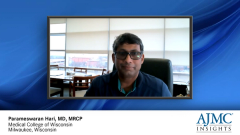
A Better Understanding of Relapsed/Refractory MM
Drs Deepu Madduri and David S. Siegel comment on what has been learned more recently about the biology and manifestation of relapsed/refractory multiple myeloma and remark on how this has impacted drug development.
Episodes in this series

Deepu Madduri, MD: Over the past 3 to 4 years especially, we’ve seen many new drugs approved, particularlyimmunotherapy approaches and antibody-drug conjugates. However, what we learned is that multiple myeloma [MM] cells have specific antigens that are expressed on the cell, such as B-cell maturation antibody, or BCMA, or GPRC5D. As such, we realized that perhaps we can train your own body’s T cells to attack and fight these cancer cells, either through bispecific antibodies, or through collecting a person’s T cells and manufacturing them in a way to attach to an antigen on a myeloma cell and destroy it.
I believe that more of the research, and more of the clinical trials are targeting this immunotherapy approach, where we can attack the myeloma cell directly, and hopefully help the patients get deeper, durable remission.
David S. Siegel, MD, PhD: The concept of relapsed/refractory multiple myeloma [RRMM] is always evolving because, “Relapsed and refractory to what?” is always the question. All patients with myeloma eventually become relapsed if they’re on an ongoing course of therapy, they are becoming relapsed and refractory. In years and decades past, after a transplant, we didn’t have a lot of choices. Recently, we developed some newer drugs, which most prominently are the anti-CD38 monoclonal antibodies.
When patients become refractory to daratumumab or isatuximab, or when they become refractory to the IMiDs [immunomodulatory drugs], with pomalidomide being the more potent of the IMiDs, and when they become refractory to carfilzomib, the most potent of the proteasome inhibitors, the outcomes have been relatively poor. It’s not so much that we have a different view of relapsed and refractory. It just means different things as we introduce new modalities into the equation. As we do that, when we fail, the patients are much more difficult to induce back into remissions.
Relapsed and refractory is not just a clinical issue, although it is the most important issue because we need to be able to save our patients. But I think there are many laboratories out there now that have given us much greater insights as to what is going on in these patients…in whom the drugs have failed. We clearly understand that there are genetic changes in the myeloma cell.
We also are understanding much more clearly that we’re selecting from pre-existing populations of cells for ones that are resistant. We are also understanding that the host is changing, that their immune system is becoming more and more fragile, and that the effector cells of the immune system are becoming both sparser and less efficient, even when they are there.
We also understand that the supporting infrastructure is changing as well, and the myeloma is conditioning the host and its microenvironment in ways that protect the myeloma cells. As we progress in understanding that biology, hopefully it’s going to translate into more effective therapies down the road.
Newsletter
Stay ahead of policy, cost, and value—subscribe to AJMC for expert insights at the intersection of clinical care and health economics.



























































